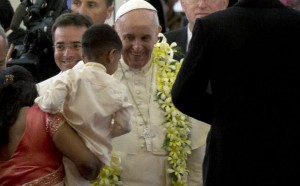
In this Tuesday, Jan. 13, 2015, file photo, Pope Francis is presented with a garland of flowers as he arrives at Bandaranaike Memorial International Conference Hall in Colombo, Sri Lanka, for an interreligious meeting. AP
COLOMBO, Sri Lanka – Despite a warning that it might rain when Pope Francis makes his highly anticipated five-day visit to the Philippines, the pontiff is pushing through with the trip.
“The Pope does not have any fear of the rain,” said Fr. Federico Lombardi, SJ, head of the Holy See Press Office.
Weather forecasters have been saying that an approaching storm would dump rain in the Philippines’ National Capital Region, where much of the Pope’s events would take place, and in the Central Visayas during the Holy Father’s visit from January 15 to 19.
A highlight of the Pope’s visit will be the Mass that he will lead in Tacloban City in the Central Visayan province of Leyte on January 17. The Eucharistic celebration will be for survivors of Supertyphoon Haiyan (Philippine name Yolanda), which killed 6,300 people and displaced at least four million in November 2013.
During his visit to Leyte, the Pope will meet victims of the typhoon and the earthquake that hit Bohol province a month earlier. The temblor killed more than 200 and destroyed ancient churches.
The Pope will end his very successful apostolic trip to Sri Lanka this morning and leave for Manila, where he is expected to arrive at 5:45 p.m., Thursday.
After the official welcome of the Roman Catholic Pontiff, who will also be on a state visit as head of the Vatican, Pope Francis will go on a motorcade to the Apostolic Nunciature in Manila, which is the top-level mission of the Holy See to the Philippines.
Pope Francis would be using a “jeepmobile,” or more familiarly a “popemobile,” during the motorcade.
Told that the motorcade’s timetable was ideal since tens of thousands of Filipinos would be lining up the streets to greet the Pope and drastically slowing down his travel, Lombardi said it would be too late to revise the schedule.
“No chance,” said the Italian Jesuit in his peculiar English about revising the papal itinerary.
When the Pope arrived in Sri Lanka on Wednesday, tens of thousands lined up the streets to greet him, forcing him to cancel an important meeting with local bishops. The long ride—all of 28 kilometers under the sun—might have taken a toll on the Pope who was visibly tired afterward.
But he appeared the next morning well and smiling when he canonized Sri Lanka’s first saint, Fr. Joseph Vaz, an Oratorian missionary priest from Goa, India, during the late 17th century.
The Pope held up Vaz as a missionary in a “multicultural context” and urged the Catholic clergy and religious to follow his example when doing their ministry in Sri Lanka, where the Buddhist Sinhalese comprise the majority and the Hindu Tamils, a sizable minority.
At least a quarter of a million people, many of them non-Christians, witnessed the canonization, making it an intercultural, inter-religious event.
On Wednesday afternoon, the Pope made a surprise visit of the Mahabodhi Buddhist temple, becoming only the second pope to visit a Buddhist shrine in history.
In 1984, Pope, now Saint, John Paul II visited a Buddhist temple in Bangkok, Thailand.
Later, Pope Francis went to the Marian shrine of Our Lady of the Rosary in Madhu.
Lombardi said that even non-Catholics visit the shrine and pay their respects to “Our Lady.”
The visit, Lombardi added, was a “profound conclusion … in a very coherent way” of the Pope’s Sri Lankan journey.
RELATED STORIES
Archbishop: Greet Pope Francis, be blessed